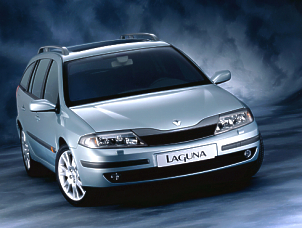
.
. .
..
. . .
Renault Concepts Renault Cars Related Topics
© 1998 - 2005 Copyright &
|
Renault : The new Renault Laguna II Two New Laguna IIs Carried through in 41 months, the X74 project was aimed at renewing Renault’s challenge in the upper-medium M2 segment, by replacing the existing Laguna and Laguna Nevada. Customers in this segment are among the most conservative in the market. Their requirements are above all for hatchback and estate car designs. And even if they do not dream about S-segment saloon cars, seen as too expensive and too luxurious, they still want to benefit from all the technical advances and equipment from the top range, but at a reasonable price. They respond to the design of the car, to its levels of comfort and of safety.
all photos: Renault The previous generation Laguna, introduced in 1994, included two types of body, the 5-door hatchback and the estate car. But the differences stopped there. Designated Laguna and Laguna Nevada, their product content was built up in the same way, their ranges were identical and their customer positioning similar. In most European markets, the estate car was therefore seen by buyers simply as a "functional large-volume" and/or "family transport" version of the hatchback. Different from each other...
With the X74 programme, Renault was responding to the needs of customers in this segment with the double offer of a 5-door hatchback and an estate car, but wanted to establish a much stronger differentiation between them. From the outset, the X74 project therefore envisaged that the two body styles would be distinct from each other. "Two cars, two philosophies, two market positions : a hatchback with the accent on expressiveness, dynamic and even sporting, and a modern estate car with the accent on aesthetics, elegant, top-of-the-range, aimed at demanding customers, a car that some people will not hesitate to class as a sports estate" explains Thierry Dombreval, Vice President, Strategy and Marketing. The differences are to be found not only in the design, but also in the content of the two cars. Each range, its equipment and the product definition is differentiated. A Laguna II estate with its "touring" philosophy, for example, which does not hesitate to show off its 210bhp V6 24V engine with its 5-speed automatic transmission with flick-shift selector, or to offer the top-range INITIALE equipment level. ...and unlike no other Slightly longer than their predecessors (4.58m and 4.70m compared with 4.51m and 4.62m) and situated above the mid-point of the M2 segment, the new Laguna II hatchback and estate have, none the less, resisted any temptation to grow bigger for the sake of it. A choice was made in order to achieve the best combination of compactness, weight, and thus the performance and economy of the car. This requirement is stressed by customers in this segment, who do not want their cars to be as long as S-segment saloons. The design of these new X74 models is deliberately one of character and expressiveness, accompanied by a search for a fluid and mobile line. "These two new Lagunas have a Latin flavour, which they combine with a Germanic rigour in the treatment of their design" explains Patrick le Quément, Senior Vice President, Corporate Design. This expressive and structured aspect is most notably seen in the taut shape, the incisive lines and the wide-shouldered upper body side sections. The front-end design seeks deliberately to emphasise the car’s width. Situated among the ranks of dynamic, even sporting cars, the hatchback adopts an approach which is unusual in this segment: an absence of the rear quarter windows and wrap-around of the rear hatch itself which is typical of Renault. It is a back end which is also notable for the wide horizontal lamp clusters and for the largely visually undefined upper section of the hatch. The short rear overhang allows the "propulsive" aspect of the car to be emphasised. "The feeling of a 4-door coupé" adds Patrick le Quément. The quest for elegance in the estate version was assisted by a rear section of extremely graphic design. A car which, according to Patrick le Quément, has been "made deliberately highly desirable when the motivation is usually professional and practical". the design of the rear side windows in a circular arc allows the line of the door windows to be continued while still emphasising the presence of the rear pillar. This window design itself blends with that of the rear lamp clusters which significantly extend around the body sides. The "touring" aspect is emphasised by the design of the rear door, with its inclined upper section incorporating a flat window in the shape of an open V. Inside the Laguna II, the overall feeling and travelling comfort express the Renault company philosophy: an interior in which all occupants are treated as equally important within a cabin whose colours are above all clear and luminous. The design of the dashboard reflects the exterior design approach: taut and structured lines, pronounced double curvatures. To achieve a different look, perceived quality is equally important: control of clearances, the selection of materials with the use of thermo-grained finishes (dashboard and door panels) or soft-feel paint on several parts of the dashboard. The interior and exterior door handles, the Renault lozenge incorporating the opening flap of the rear door, the new wheels and even the new gear lever knobs all express the care which has gone into the car’s design. The Laguna II is a car with a high technological content, but it still remains faithful to the Renault spirit: the technology is abundant but discreet, with simplified man-machine interfaces, with no superfluous information or unnecessary controls. This image of systems integration is seen in the keyless "Carte Renault", the new integrated radios, or the new air conditioning system.
|
. |











